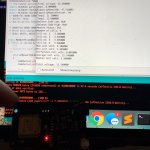Alloy
Well-known member
Good to know, I've done it for large battery lugs (blow torch, fill cup with solder, insert 2 gauge wire, hammer crimp quickly) think I saw that somewhere on youtube and it made sense given that my hammer crimps weren't always precise. I did it for the small uninsulated balance leads on the portable packs I built just to get the tiny bit of wire poking out of the tunnel on to the surface of the ring terminal flat. I'll just up my crimper game and get something ratcheting. If I did more large battery cables I'd throw the hammer crimper in the trash and get a hydraulic one.
I charged the pack up to 3.45Vpc last night and then started a discharge @ 20 amps before going to bed. It's still going, 170ah consumed. Under this constant load and with 170ah taken, the cells are fluctuating between 10-15mV difference. If I flip off the load they go back to 1-3mV. Cells all reading 3.15v with load and at this low SOC. Would assume the seller claims of capacity are accurate but I don't want to push it and have to watch the cell monitor like a hawk. Also would never draw 170ah in service so i'll conclude this discharge momentarily. Pretty thrilled right now. The BlueSea terminal mount bus bars will be here Saturday, the last thing I need to complete assembly in to its ammo can home.
Only thing I might add if I can find something of quality, are adhesive backed 12v heat strips. Use load output on charge controller to operate a 12v temperature controller that powers the heat strips below 45*F. That'll keep it warm and capable of accepting charge this winter and I can't assume heating a near sealed ammo can would require a ton of power even with ambient temps well below freezing.
While that'd respect the battery by operating in configured boundaries of the load output, I think it'd also make the heater operate at midnight when it doesn't need to. Maybe I can add something between load output and the thermostat, like a light sensor. If bed of truck is pitch black, don't bother heating it. That might cause some delay in charge kicking on in the morning (sense light, work for an hour to get the box up to temp when it could be charging had it been warming earlier) but worth a test. Any ideas?
I used to solder anything over 8ga. Later found the solder had melted out of some. If I was doing rework the copper would be brittle close to the solder lug and the wire would be green even if it was cut back 4"-6". I learn later that the insulation on the wire is water permeable. Everything I do now is tinned wire / crimped / and coverd with adhesive lined heat shrink.
If you used heat pads leave an air gap between the pads and the battery. Heat will damage Lithium just as much as cold does.











